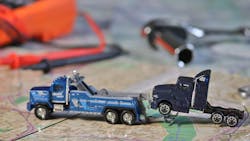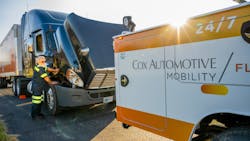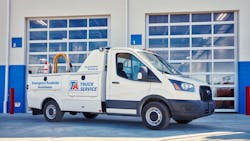The best preventive maintenance program in the world can’t completely eliminate all emergency roadside events. Unexpected breakdowns will happen eventually, and it’s important for fleets to have a well-defined response plan in place before they do.
“Emergency service can be very expensive and can have extended response times,” said Joe Puff, VP of truck technology and maintenance at NationaLease, a provider of full-service leasing and contract maintenance services. “When a breakdown occurs, it can be quite frustrating trying to find a service provider in an unfamiliar area. That’s not the time to develop a plan. Every commercial fleet should have a repair protocol playbook for breakdowns.”
According to Puff, that playbook should include a list of prearranged service providers with emergency contact information, along with a tire service, towing company, and mechanical repair provider for the areas of operation.
If a vehicle can be driven to a shop, TravelCenters of America advises that’s the way to go.
“The moment you decide to try and handle an issue at roadside, the cost goes up,” said Daniel Mustafa, director of technical service at TravelCenters of America, which employs nearly 3,000 technicians at its TA Truck Service Centers across the country. That’s because roadside labor rates tend to be higher, and other costs like parts retrieval and drive time are often added to the repair bill.
That said, when a vehicle can’t be driven to a shop, a fleet’s choice becomes roadside repair versus a costly tow.
See also: Heavy-duty repair report shows shop revenue recovery, higher technician pay
Most common roadside repairs
While a vehicle could go down for a long list of reasons, there are a handful that are the most common for fleets. Matt Copot, VP of maintenance at Transervice Logistics, a provider of freight management, fleet leasing, and contract maintenance services, said the top four roadside issues they encounter are:
- Tires
- Brakes (lines and fittings, gladhands, chambers)
- Cranking system (jumpstarts, batteries, starters)
- Exhaust system (aftertreatment devices, SCR)
Interestingly, the first two items on Copot’s list are identical to the top two reasons commercial vehicles are placed out of service in the U.S. The silver lining is that many of the safety issues caught at the roadside can be resolved there as well.
“The fleet has three options: fix it, float it, or tow it,” said Kerri Wirachowsky, director of inspection programs at the Commercial Vehicle Safety Alliance (CVSA). Fixing it largely comes down to what exactly needs fixing but also where the vehicle has been pulled over.
“When I used to do inspections and had someone at a fixed scale location, the technicians doing roadside work seemed to have every piece of equipment known to man,” Wirachowsky said. “They could do spring jobs and repair leaking wheel seals and just about anything. But when you’re at the side of the road, fixing an air hose or adjusting brakes is one thing. Doing a wheel-end job? Not so much. In that case, the fleet would typically want to have it towed.”
Wirachowsky said there are other instances where a fleet may choose to have the vehicle towed to a shop. If the truck isn’t too far from a shop, it could prove to be more cost-effective to have it towed a short distance so the vehicle can be repaired under a roof. But if the nearest shop is nowhere close, the fleet could be looking at a hefty towing bill in addition to the cost of repairs. Calling an emergency roadside service may be the best option.
See also: Fleets moving from preventive to predictive maintenance save more
Sizing up the service call
Once the vehicle is parked safely and the emergency equipment is deployed to alert motorists, the driver should do their best to identify the exact nature of the defect. This will help dispatch determine the best road service response to call in.
“If it’s a tire blowout, a tire provider could be called,” Copot said. It is helpful if the driver can identify the size of the tire and the proper wheel position. “Equally important is informing the road call service if the wheel has been damaged so they can dispatch the parts necessary to repair or replace.”
As a follow-up, remember that if the wheel end is taken off for a repair, a torque check should be performed 50 to 100 miles down the road.
“Improper installation will typically result in torque loss shortly after the vehicle has returned to service,” noted Kevin Rohlwing, SVP of training at the Tire Industry Association. “A simple torque check down the road after tire service will help ensure that nothing is loose and prevent wheel-off accidents from happening.”
Aside from tires, there are many other roadside repairs that are well within a good roadside service provider’s grasp.
“Our mobile technicians are some of the most well-rounded technicians in the industry,” said Larry Fowler, fleet service manager for Cox Automotive Mobility Fleet Services, a nationwide provider of scheduled and unscheduled maintenance for fleets. “Mobile technicians do not have the luxury of being a specialist. They are experienced and trained in all aspects of truck repair and see a full variety each day.”
To that point, Fowler said Cox’s mobile services include basic PMs like fluid and filter changes, but also transmission, differential, and exhaust filter services, as well as overhead engine adjustments.
See also: Cox Automotive acquires FleetNet America
Of course, there could be instances where roadside service is likely not an option. Like with tire blowouts, the driver should relay all necessary information to dispatch so the appropriate next steps can be identified.
“If there is a mechanical situation, the driver should investigate and take note of any details they may have noticed prior to the breakdown that would indicate the severity of the failure,” Copot explained.
For instance, if the driver noticed a loud bang and an immediate loss of power and oil coming out of the exhaust stack, that would be indicative of a turbo failure. “In this case, it’s highly unlikely that a road call would be able to repair. The best remedy would be to call for a tow truck,” Copot said.
Technician safety is another consideration.
Mustafa said TA Truck Service mobile technicians typically avoid top-of-trailer repairs at roadside due to risks created by traffic and wind gusts. “But that doesn’t mean we wouldn’t look at making that type of repair if the vehicle were parked safely in a parking lot or something like that,” Mustafa added.
TA Truck Service technicians also refrain from attempting roadside repairs when the repair itself may render the vehicle unstable. “An example would be an air spring or airbag replacement,” Mustafa related. “If the vehicle is made unstable by removing its support, passing traffic could make the vehicle rock which puts the technician at risk.”
Coordinating the call
For example, Continental’s TrukFix app allows fleets to submit tire-related service issues to Continental’s Tire Support Unit (TSU). This eliminates any potential wait times when calling the 24/7 emergency call center.
“We now use the TrukFix app 99% of the time as opposed to calling,” said Brian Rigg, fleet service center manager for Trimac Transportation, a Canadian-based bulk carrier with more than 140 branches across North America. “The TrukFix app is very simple and user-friendly. The other nice thing is that the form you fill out makes sure all of the important information is gathered so Continental can figure out the best thing to do.”
For many larger fleets, including Trimac, the internal process is for the driver to call their dispatch. Dispatch follows the form in the TrukFix app to ask the driver a series of questions. After typing in the information, the driver conveys, dispatch clicks to submit the request to Continental, which then reviews the information and identifies the exact location of the vehicle through GPS tracking. The appropriate course of action is taken from there. “A case number is also provided should any follow-up calls be needed later,” Rigg added.
According to Kaitlyn Landreth, TSU supervisor at Continental Tire the Americas, TSU staff often don’t even have to speak with a dispatcher. The key is having an app that is thorough and easy to use.
“When we initially began creating the TrukFix app, we took a deep dive into not only the information we needed to provide a service technician but also the information our fleet customers wanted to see reported back to them on their invoice,” Landreth said. “We knew we needed something that would be easy for drivers and dispatchers to go, ‘bam, bam, bam, done.’ Additionally, the less time we are on the phones gathering information, the more time we can spend elsewhere to help get a driver safely off the side of the road.”
TA Truck Service has begun testing its own web-based process for drivers and fleets to track repairs. Again, the objective isn’t to replace human beings in the 24/7 call center. The goal is to enhance the process and make it more efficient for everyone involved.
Some fleets lean on third-party roadside assistance providers for the most efficient process.
For instance, Maverick Transportation uses a service called TTN Fleet Solutions. “This web-based platform allows the driver to fill out a quick form that is submitted to TTN’s driver support center,” said Brent Hilton, director of maintenance at Maverick Transportation based in North Little Rock, Arkansas. Once submitted, a work order is automatically created, and Maverick’s maintenance coordinator is alerted. Some back and forth ensues between the driver and maintenance coordinator to better troubleshoot the situation and determine whom to call.
If it is determined that roadside service is the best option, Hilton said TTN leverages its expansive list of preferred vendors. Maverick’s district service managers are tasked with building relationships with these vendors on an ongoing basis. As is the case in most facets of business, a strong pre-existing relationship with a service provider certainly comes in handy when you’re in a pinch.
To establish its roster of preferred vendors, Maverick personnel fill out surveys to help grade vendor performance.
“We look at everything from the cleanliness of their shop to how nicely their technician treated one of our drivers on a past service call,” Hilton said. “And, of course, we want partners who do quality work safely and get our drivers back on the road as fast as possible.”
When it is determined that the vehicle needs to be towed, Hilton said it goes to the nearest dealership because most of Maverick’s trucks are under warranty.
“The telematics system we use allows us to pinpoint the exact location of the truck,” Hilton said. “Also, our system tells us which direction the load is going so we can make sure the vehicle is towed in a positive direction, if at all possible.” Maverick’s maintenance coordinators then follow up to make sure the repair is completed as quickly as possible.
Another technology that is helping fleets better coordinate roadside service calls is Trimble Transportation’s TMT Fleet Maintenance software. The software’s Road Call functionality enables fleets to capture breakdown details, asset location, fault codes, and repair history. TMT then assists fleets in making informed decisions of how, when, and where to repair.
“Additionally, commercial location data from Trimble Maps is built right in, allowing for easy vendor selection,” said Dave Walters, senior solutions engineer for Trimble Transportation, a provider of technologies that help fleets improve the routing, tracking, and maintenance of their assets.
Emerging technologies like remote diagnostics are also helping fleets resolve roadside issues faster and at a lower cost.
For example, Navistar’s OnCommand Connection (OCC) is an open architecture connected vehicle platform that can collect data from factory-installed telematics devices and more than 30 commercially available telematics service providers.
When a vehicle has a fault, OCC shows the fleet manager a detailed description of the situation in everyday language. OCC also explains whether the vehicle needs to be stopped immediately or can be driven further. Finally, the system can direct the customer to the nearest repair facility with the parts, technician skillset, and diagnostics tools required to complete the repair in a timely fashion.
“Fleets acting on the insights have experienced a significant reduction in unplanned service events, reducing vehicle downtime and avoiding towing costs,” said Srinivas Mallela, director of connected services at Navistar, a heavy-duty truck manufacturer whose brands include International.
Starting in 2023, all International Classes 6 through 8 vehicles will come with a factory-installed telematics device. For all other vehicles, fleets can choose an aftermarket OCC telematics device or commercially available device that is approved by Navistar’s OCC team.
“We are also launching a new mobile application, recognizing that some customers don’t stay behind a desk and need to understand how their fleet is performing in real-time while on the go,” Mallela said. “Additionally, we are constantly expanding our connected technology solutions and will be offering over-the-air software update capabilities for our new International S13 Integrated Powertrain when that enters production later in 2023.”
Connectivity and technology in general continue to have a positive impact on all facets of fleet maintenance, roadside emergencies included. By leveraging some of these new tools to augment the other hallmarks of a good roadside breakdown playbook, fleets can have a little more peace of mind when something goes wrong on the road—because you know at some point, it eventually will.
This article originally appeared on Fleet Maintenance, a sister publication of FleetOwner.
About the Author
Gregg Wartgow
Gregg Wartgow covers the trucking and maintenance industries for Endeavor Business Media's Commercial Vehicle Group, which includes Fleet Maintenance and FleetOwner.




